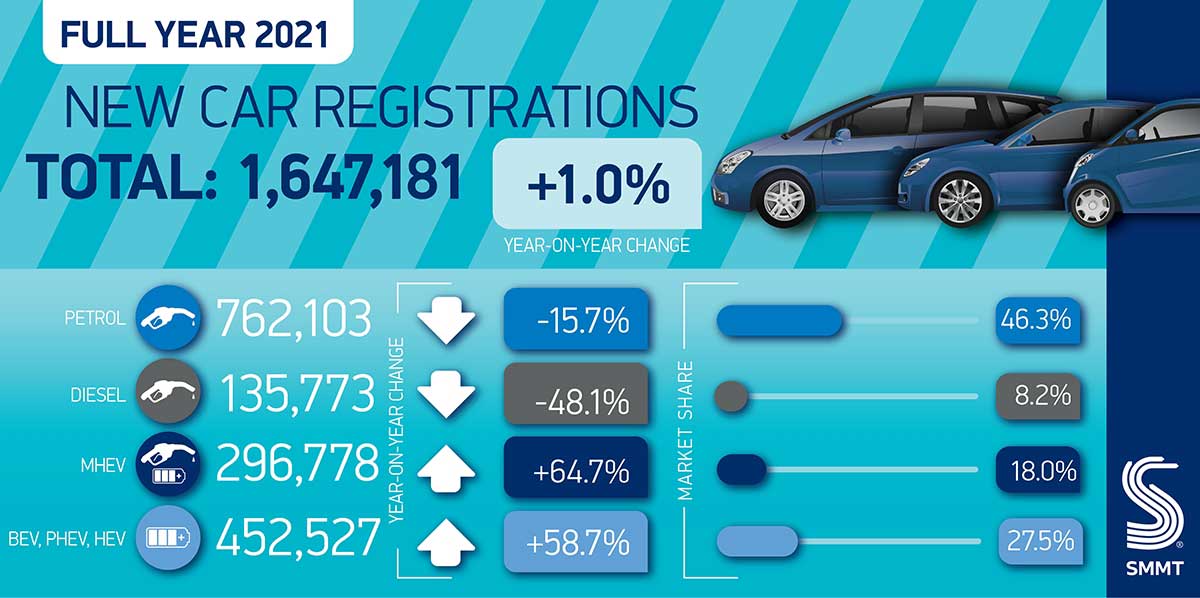Europe is ‘where the action is’ for observing how an EV transition happens and how best to manage it. There, month by month sales of plug-in EV (PEVs) sales have been growing and internal combustion engine (ICE) car sales continue in a decline that began around 2017.
In addition, Norway has been showing the way on how the end-game for internal combustion engine (ICE) car sales will play out.
For Australians, the most interesting part of the European EV market to watch is the UK. This is due to it being a right-hand drive vehicle market (unlike the rest of Europe). EVs released there are effectively ready to bring to Australia, should the manufacturers elect to do so.
So what is happening there in terms of UK sales figures, policy, model choice and manufacturer announcements? 2021 saw the overall UK new car market rise a mere 1% above their 2020 Covid ravaged figure – but leaving their market still 28.7% below 2019’s (pre-Covid) level.
On the other hand, overall new PEV sales hit 27.5%, diesel cars slumped by nearly half to 8.2% and petrol ones fell from 62% to 46.3%. Whilst more than 40% of models available in the UK now have plugs, it is worth noting here that the UK is still only placed ninth in terms of European market share for BEVs.
It is also worth remembering that in the UK, the number of public EV chargers surpassed the number of petrol stations in 2019!

New models are also being announced for the UK almost daily – some of the latest include:
Vauxhall: Combo Life and Vivaro Life vans to be full-electric only from this year. Vauxhall recently also announced that they will be exclusively electric by 2028. Coupled with the announcement were price reductions of £2,000 – £3,000.

Peugeot: Rifter and Traveller vans now sold as electric-only.
Citroen: e-Berlingo Electric and e-SpaceTourer Electric are now the only versions of Berlingo and SpaceTourer (passenger models) available for future orders – all equivalent internal combustion models have been removed from the UK range.
So, where is the transition sitting now in the UK? The UK government has brought forward the sales ban date for ICE vehicles to 2030 (Europe-wide ban date is now 2035), introduced a mandate to install EV charging in all new homes and businesses (starting this year).
In addition, they see EV subsidies as less necessary to promote EV take-up now that sales are booming, as model choice is expanding and prices are falling. As a result, the UK Plug-in Car Grant has been lowered from a maximum of £2,500 (Au$4,700) to £1,500 (Au$2,800).
It now seems that regardless of what national EV and emissions policies (or lack thereof) are in place here, the EV transition has gained a now unstoppable momentum.
As such, Europe (and in particular the UK) give excellent pointers to what will happen over the next 5 to 10 years here in Australia.
With luck, these overseas examples and experiences will soon be used to develop the long-delay EV Transition policies we so need. (Or if not, perhaps used by the general public to shape their voting choices at the next federal election …)

Bryce Gaton is an expert on electric vehicles and contributor for The Driven and Renew Economy. He has been working in the EV sector since 2008 and is currently working as EV electrical safety trainer/supervisor for the University of Melbourne. He also provides support for the EV Transition to business, government and the public through his EV Transition consultancy EVchoice.

